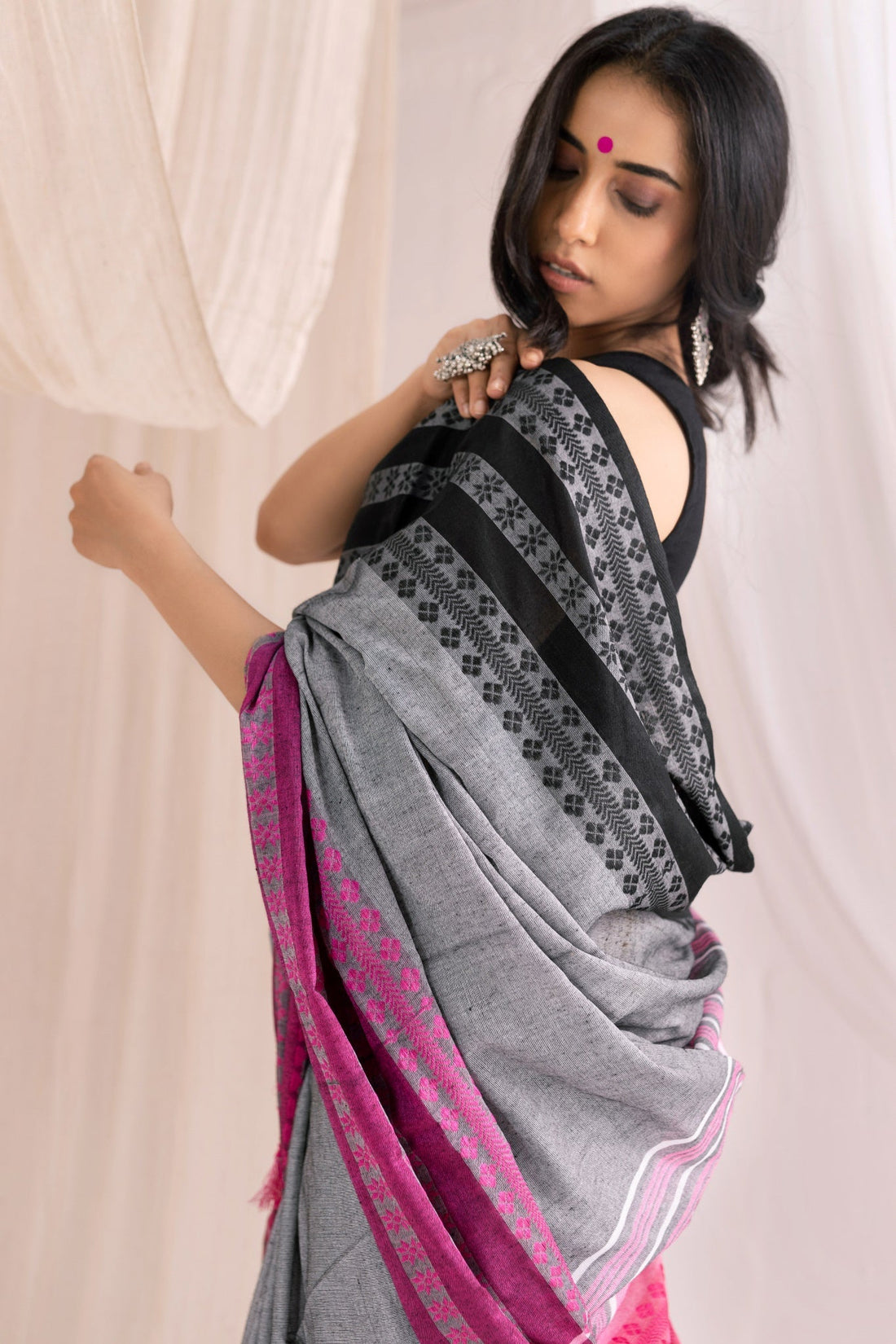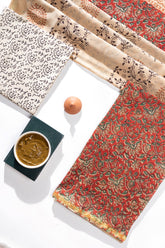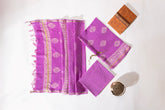The art of creating beautiful begumpuri saree blouse designs at home has become increasingly popular among women who appreciate traditional Bengali craftsmanship. These handloom sarees, originating from the town of Begumpur in West Bengal, deserve equally stunning blouse designs that honor their heritage while offering modern comfort and style.
Creating your own DIY begumpuri blouse patterns allows you to customize fit, style, and detailing to perfectly complement your precious handloom saree. Whether you're a beginner or experienced in saree blouse tailoring, this comprehensive guide will walk you through five traditional blouse cuts that beautifully enhance begumpuri cotton sarees.
Understanding Begumpuri Cotton Sarees: The Foundation for Perfect Blouse Design
Before diving into specific blouse patterns, it's essential to understand what makes begumpuri cotton sarees special. These easy-to-maintain cotton sarees do not require frequent starching. Begumpuri sarees with deep and bright colours, are characterised by loosely woven coarse structure with a smooth feel. Handwoven by skilled artisans, our Begampuri Bengal Cotton Sarees showcase intricate patterns and vibrant colors that pay homage to the artistry of the region. The lightweight and breathable fabric drapes gracefully, offering both elegance and ease.
The unique characteristics of begumpuri cotton sarees include:
Fabric Properties:
- Lightweight and breathable cotton construction
- Loosely woven texture with a smooth finish
- Vibrant, fade-resistant colors
- Natural draping quality
Design Elements:
- Contrasting borders in traditional colors
- Intricate motif patterns
- Regional Bengali artistic influences
- Handwoven imperfections that add character
Understanding these qualities helps you choose the right blouse design that complements rather than competes with your saree's natural beauty.
Essential Tools and Materials for DIY Begumpuri Saree Blouse Crafting
Success in home tailoring projects depends on having the right tools and materials. Here's what you'll need for creating professional-looking begumpuri saree blouse designs:
Basic Sewing Equipment:
- Sharp fabric scissors
- Measuring tape
- Pins and needles
- Seam ripper
- Sewing machine (or hand-sewing supplies)
- Iron and ironing board
- Tailor's chalk or fabric markers
Fabric Selection:
- Cotton or cotton-blend fabrics that complement your saree
- Silk for more formal occasions
- Matching or contrasting thread
- Interfacing for structured areas
- Zipper or hooks for closure
Pattern Making Supplies:
- Pattern paper or newspaper
- Ruler and curves
- Pencil and eraser
- Fabric measuring guide
The key to successful traditional stitching techniques lies in preparation and patience. Take accurate measurements and create a test fitting before cutting your final fabric.
Traditional Begumpuri Blouse Cuts: 5 Classic Styles
1. The Classic High-Neck Bengal Blouse
The high-neck blouse represents one of the most traditional bengal blouse styles for begumpuri sarees. This timeless design offers modest coverage while maintaining elegant proportions.
Design Features:
- Conservative neckline reaching just below the collar bone
- Three-quarter sleeves with fitted cuffs
- Straight or slightly fitted silhouette
- Traditional button or hook closure
Pattern Creation Process: Start by measuring your bust, waist, shoulder width, and desired blouse length. The high-neck design requires careful attention to the neckline curve to ensure comfort without being too tight.
Stitching Technique:
- Cut two front pieces and one back piece
- Create the neckline by folding and finishing edges
- Join shoulder seams first
- Attach sleeves using traditional set-in sleeve method
- Sew side seams from sleeve cuff to hem
- Finish all seams with French seams for durability
This classic cut works beautifully with begumpuri cotton saree blouse ideas that emphasize traditional elegance. The high neckline balances perfectly with the saree's flowing drape.
2. The Boat Neck Contemporary Style
For those seeking a modern twist on traditional blouse patterns, the boat neck design offers sophistication while honoring Bengali styling traditions.
Design Characteristics:
- Wide, horizontal neckline
- Sleeveless or cap sleeve options
- Fitted through the torso
- Clean, minimalist lines
Construction Details: The boat neck requires precise pattern drafting to achieve the correct neckline width without compromising fit. This style particularly suits women with narrow shoulders as it creates a broader silhouette.
Tailoring Tips:
- Use bias tape to finish the neckline for a professional look
- Ensure adequate ease across the chest
- Consider adding princess seams for better fit
- Choose fabrics with good drape for best results
This contemporary approach to begumpuri saree blouse tailoring techniques appeals to modern women while respecting traditional aesthetics.
3. The Princess Cut Fitted Blouse
The princess cut represents sophisticated traditional garment making, offering excellent fit through strategically placed seams that follow the body's natural curves.
Structural Elements:
- Vertical princess seams from shoulder to hem
- Fitted silhouette without darts
- Various neckline options
- Structured support through seaming
Pattern Development: Creating a princess cut pattern requires advanced pattern-making skills. The design divides the front and back pieces into panels that shape the garment.
Advanced Techniques:
- Draft the basic bodice pattern
- Draw princess seam lines
- Split pattern pieces along these lines
- Add seam allowances
- Create mock-up for fitting
- Adjust for perfect fit
This cut exemplifies the artistry possible in handmade blouse patterns for begumpuri cotton sarees, offering both traditional appeal and modern fit.
4. The Puffed Sleeve Traditional Design
Puffed sleeves add a romantic, vintage touch to begumpuri saree blouse design ideas at home. This style draws inspiration from historical Bengali fashion.
Design Elements:
- Gathered fullness at the shoulder
- Fitted cuff at the wrist
- Various puff sizes from subtle to dramatic
- Traditional neckline options
Construction Process: The key to successful puffed sleeves lies in calculating the correct amount of fullness and distributing it evenly around the armhole.
Sewing Steps:
- Cut sleeves with extra width for gathering
- Create gathering stitches at the sleeve cap
- Attach cuff pieces to sleeve ends
- Gather sleeve cap to fit armhole
- Set sleeves into armhole
- Finish all seams neatly
This style works particularly well with more formal begumpuri sarees, adding visual interest while maintaining traditional elegance.
5. The Backless Tie-Up Design
For special occasions, the backless tie-up design offers glamour while incorporating traditional elements. This style requires confidence and is perfect for evening events.
Design Features:
- Open back with tie closure
- Various front neckline options
- Fitted through the torso
- Decorative tie elements
Pattern Modifications: Start with a basic blouse pattern and modify the back to create the open design. Consider the weight and drape of your begumpuri saree when determining the amount of back coverage.
Safety Considerations:
- Ensure adequate support through internal construction
- Test fit carefully before final construction
- Consider adding stays or boning for support
- Choose appropriate undergarments
This dramatic style showcases the versatility possible in ethnic blouse designs while maintaining respect for traditional craftsmanship.
How to Design Blouses for Begumpuri Cotton Sarees: Step-by-Step Guide
Creating the perfect blouse for your begumpuri saree involves careful planning and execution. Here's a comprehensive approach to the design process:
Phase 1: Planning and Design
Color Coordination: Study your saree's color palette and choose blouse colors that either complement or provide attractive contrast. Traditional combinations include:
- Deep jewel tones with lighter sarees
- Metallic accents with richly colored sarees
- Monochromatic schemes for sophisticated looks
- Traditional color combinations like red and gold
Style Selection: Consider the occasion, your body type, and personal preferences when choosing from the five traditional cuts outlined above.
Phase 2: Pattern Creation
Measurement Taking: Accurate measurements are crucial for successful DIY begumpuri saree blouse stitching guide results. Key measurements include:
- Bust circumference
- Waist measurement
- Shoulder width
- Arm length
- Desired blouse length
- Neckline preferences
Pattern Drafting: Create your pattern on paper first, allowing for adjustments before cutting expensive fabric. Include seam allowances and match points.
Phase 3: Fabric Preparation
Pre-Treatment: Always pre-wash and press your fabric to prevent shrinkage after construction. This step is particularly important for cotton fabrics.
Layout and Cutting: Plan your fabric layout carefully to make the most efficient use of material while ensuring all pieces follow the correct grain line.
Phase 4: Construction
Fitting Process: Create a muslin mock-up for complex designs to test fit before cutting final fabric. This step saves time and materials while ensuring perfect results.
Professional Finishing: Pay attention to finishing details like seam treatments, hems, and closures. Quality finishing distinguishes handmade garments from homemade ones.
Traditional Blouse Patterns for Begumpuri Handloom Sarees: Regional Influences

Bengali blouse traditions have evolved over centuries, incorporating influences from various periods and regions. Understanding these historical contexts enriches your appreciation for traditional stitching techniques.
Historical Development
Colonial Era Influences: British colonial period introduced tailored elements to traditional Indian garments, leading to more fitted blouse styles.
Regional Variations: Different areas of Bengal developed distinct blouse styles based on local preferences and available materials.
Modern Evolution: Contemporary designers continue to reinterpret traditional patterns, creating fresh approaches to classic designs.
Cultural Significance
Ceremonial Importance: Different blouse styles hold significance for various occasions, from daily wear to wedding ceremonies.
Artistic Expression: Blouse design offers opportunities for personal artistic expression while honoring traditional craftsmanship.
Community Connection: Learning traditional techniques connects modern practitioners with generations of skilled artisans.
5 Classic Blouse Cuts for Begumpuri Cotton Sarees: Detailed Construction
Advanced Techniques for Each Cut
Cut 1: High-Neck Traditional
- Collar stand construction
- Invisible zipper installation
- French seam finishing
- Traditional button loop closures
Cut 2: Boat Neck Contemporary
- Bias binding techniques
- Stabilizing horizontal necklines
- Clean edge finishing
- Modern closure methods
Cut 3: Princess Cut Fitted
- Curved seam construction
- Bust adjustment techniques
- Precision fitting methods
- Professional pressing techniques
Cut 4: Puffed Sleeve Traditional
- Gathering calculations
- Sleeve cap setting
- Cuff construction
- Proportion balancing
Cut 5: Backless Tie-Up
- Internal support construction
- Decorative tie creation
- Security considerations
- Balance and proportion
Ethnic Blouse Designs: Incorporating Traditional Elements
Decorative Techniques
Embroidery Options:
- Hand embroidery using traditional Bengali motifs
- Machine embroidery for quicker results
- Appliqué work using contrasting fabrics
- Beadwork and sequin embellishments
Fabric Manipulation:
- Pleating and tucking for texture
- Smocking for fitted areas
- Gathering for decorative effect
- Bias cut elements for drape
Traditional Motifs
Bengali Patterns:
- Fish motifs (symbols of prosperity)
- Paisley designs
- Floral patterns
- Geometric borders
Application Techniques:
- Transfer methods for complex designs
- Freehand embroidery skills
- Template creation
- Color selection for motifs
Handcrafted Blouse Ideas: Personalizing Your Design
Customization Options
Fit Adjustments: Every body is unique, and successful home tailoring projects require personalized adjustments. Common modifications include:
- Bust adjustments for proper fit
- Shoulder slope modifications
- Sleeve length alterations
- Waist shaping adjustments
Style Variations:
- Neckline modifications
- Sleeve length changes
- Hem treatments
- Closure options
Creative Additions
Unique Details:
- Contrasting piping
- Decorative buttons
- Lace trim applications
- Fabric combinations
Personal Touches:
- Monogramming
- Family heirloom incorporations
- Color story development
- Texture combinations
DIY Clothing Projects: Building Your Skills
Skill Development Progression
Beginner Level: Start with simple designs like the high-neck traditional cut. Focus on basic construction techniques and proper finishing.
Intermediate Level: Progress to more complex cuts like the boat neck or princess cut. Develop pattern-making skills and fitting techniques.
Advanced Level: Master complicated designs like the backless tie-up. Learn advanced tailoring techniques and perfect finishing methods.
Project Organization
Planning Phase:
- Design selection
- Material gathering
- Time allocation
- Skill assessment
Execution Phase:
- Pattern creation
- Fabric preparation
- Construction process
- Fitting sessions
Finishing Phase:
- Final adjustments
- Quality control
- Pressing and finishing
- Care instructions
Saree Blouse Crafting: Professional Tips and Techniques
Quality Construction Methods
Seam Finishes:
- French seams for durability
- Bound seams for heavy fabrics
- Pinked edges for stable fabrics
- Serged edges for stretch materials
Pressing Techniques:
- Steam pressing for cotton
- Dry pressing for delicate fabrics
- Press cloth usage
- Seam pressing methods
Troubleshooting Common Issues
Fit Problems:
- Gaping necklines
- Tight armholes
- Pulling across the bust
- Uneven hemlines
Construction Issues:
- Puckered seams
- Twisted sleeves
- Uneven gathers
- Poor closure alignment
Care and Maintenance of Handmade Blouses
Proper Storage
Organization Methods:
- Hanging vs. folding
- Protective coverings
- Climate considerations
- Pest prevention
Seasonal Care:
- Rotation schedules
- Condition assessment
- Preventive maintenance
- Professional cleaning needs
Cleaning Guidelines
Fabric-Specific Care:
- Cotton blouse care
- Silk blouse maintenance
- Embellished blouse cleaning
- Stain removal techniques
Longevity Tips:
- Proper handling
- Wear rotation
- Minor repair techniques
- Professional restoration
Frequently Asked Questions
Q: What's the best fabric for begumpuri saree blouse designs?
A: Cotton fabrics work best as they complement the natural fiber content of begumpuri sarees. Choose cotton that matches the weight and drape of your saree for the most harmonious look.
Q: How long does it take to make a DIY begumpuri blouse?
A: For beginners, expect 8-12 hours spread over several sessions. Experienced sewers can complete a blouse in 4-6 hours. Complex designs with embellishments require additional time.
Q: Can I modify traditional patterns for modern fits?
A: Absolutely! Traditional patterns serve as excellent starting points for contemporary modifications. Adjust necklines, sleeve lengths, and silhouettes while maintaining the essential character of the design.
Q: What's the most beginner-friendly blouse cut?
A: The high-neck traditional cut offers the most forgiving construction for beginners. It requires basic sewing skills and provides good coverage for fit imperfections.
Q: How do I ensure my handmade blouse looks professional?
A: Focus on proper fitting, clean finishing techniques, and attention to detail. Press seams carefully, finish edges neatly, and take time with final adjustments.
Q: Should I use interfacing in my blouse construction?
A: Interfacing helps maintain shape in areas like necklines and button bands. Use lightweight interfacing for cotton fabrics to avoid stiffness.
Q: How do I choose the right blouse color for my begumpuri saree?
A: Consider contrasting colors for dramatic effect or complementary shades for subtle elegance. Traditional combinations include deep jewel tones with lighter sarees.
Q: What's the difference between machine and hand sewing for blouse construction?
A: Machine sewing offers speed and consistency, while hand sewing provides control and traditional authenticity. Many sewers combine both techniques for optimal results.
Conclusion: Mastering the Art of Begumpuri Blouse Design
Creating beautiful begumpuri saree blouse designs at home represents more than just a sewing project—it's a connection to rich textile traditions and personal creative expression. The five traditional cuts outlined in this guide provide a solid foundation for developing your skills in ethnic wear customization.
Whether you choose the modest elegance of the high-neck traditional style, the contemporary sophistication of the boat neck, the fitted perfection of the princess cut, the romantic appeal of puffed sleeves, or the dramatic flair of the backless design, each pattern offers unique opportunities for personal expression while honoring Bengali craftsmanship traditions.
Success in home tailoring projects comes from patience, practice, and attention to detail. Start with simpler designs and gradually progress to more complex patterns as your skills develop. Remember that handmade garments carry special value—they reflect your personal style, fit your body perfectly, and connect you to generations of skilled artisans who have preserved these traditional techniques.
Your begumpuri cotton saree deserves a blouse that complements its beauty and craftsmanship. By mastering these traditional stitching techniques and adapting them to your personal style, you'll create blouses that not only look professional but also carry the satisfaction of being truly handmade.
The journey of learning artisanal clothing design continues with each project. Document your progress, learn from challenges, and celebrate your successes. Most importantly, enjoy the process of creating beautiful garments that honor both tradition and personal style.
Whether you're preparing for a special occasion or simply want to expand your wardrobe with unique pieces, these begumpuri saree blouse designs offer endless possibilities for creativity and self-expression. Embrace the art of traditional garment making and discover the joy of creating beautiful, wearable art with your own hands.









